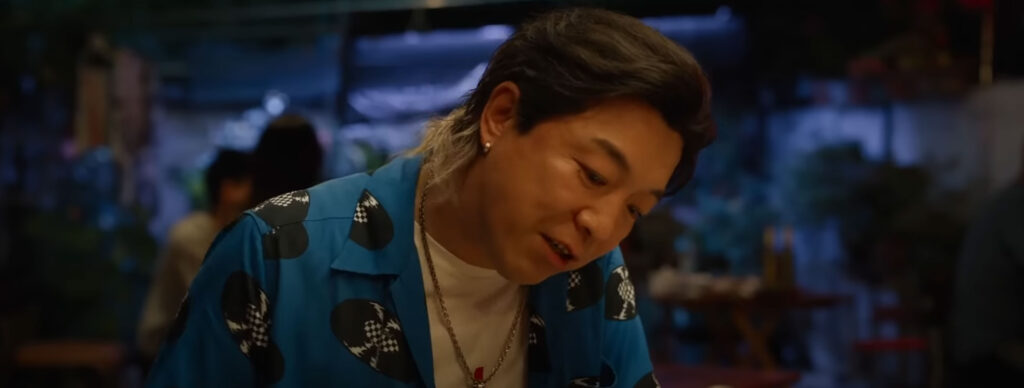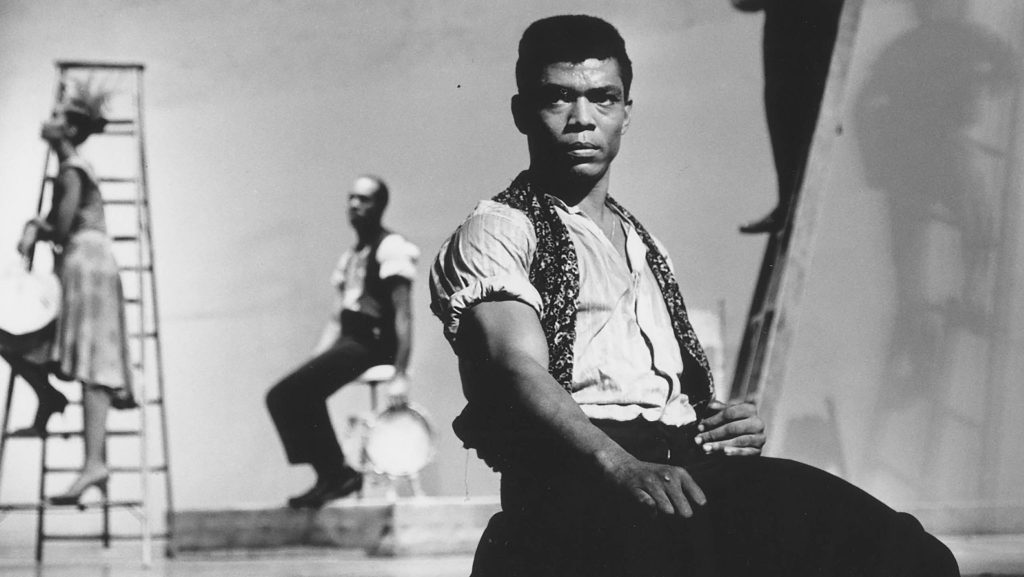August 14, 2023
by Carla Hay

Directed by Da Peng
Mandarin with subtitles
Culture Representation: Taking place primarily in Hangzhou, China, in 2022, in comedy/drama film “One and Only” features a predominantly Asian cast of characters (with a few white people and one black person) representing the working-class, middle-class and wealthy.
Culture Clash: A talented street dancer is recruited as a stand-in on a high-ranking street dancing team that will be competing for a national championship, but he and the team’s coach have obstacles along the way, including a jealous and wealthy rival who threatens the team’s existence.
Culture Audience: “One and Only” will appeal primarily to people who are interested in watching modern dance movies that have great choreography and well-acted stories.

“One and Only” is one of the best dance films of the year. The choreography and cinematography are dazzling. This comedy/drama about an underdog street dancer and his conflicted coach also has a compelling and heartfelt story told with skillful acting. The story’s overall plot is entirely predictable, but viewers are taken on a thoroughly entertaining ride along the way.
Directed by Da Peng (who co-wrote the “One and Only” screenplay with Siu Bao), “One and Only takes place primarily in Hangzhou, China, in 2022. Hangzhou is the hometown of Chen Shuo (played by Wang Yibo), a talented street dancer in his late teens or early 20s. Shuo is juggling three different jobs to help pay the bills for his family, which includes his widowed mother Du Li Sha (played by Liu Min Tao) and his mother’s brother (played by Yue Yunpeng), who all live in the same household. (The movie doesn’t say how Shuo’s father died. Shuo’s maternal uncle doesn’t have a first name in the movie and is only identified as Uncle Du in the end credits.)
Shuo works in the small, casual restaurant owned by his mother, who used to be a professional singer. He also has a job at a car wash. And in his spare time, Shuo does dance jobs on the street or at parties. For his dancing gigs, Shuo works with his uncle Xie (played by Xiaoshenyang), who is the brother of Shuo’s deceased father. Xie, who is very supportive of Shuo, also acts as a quasi-manager/agent to Shuo.
Shuo’s dream is to become a professional street dancer, just like Shuo’s father was. Shuo is in awe of E-Mark, the hottest street dance team in Hangzhou, and he goes to as many of E-Mark’s performances as possible. An early scene in the movie shows Shuo rushing from completing a street dancing gig that pays him ¥300 (which is about $41 in U.S. dollars in 2022) so that he can watch E-Mark compete in the finals of the Zhejiang Street Dance Competition. The winner will have a chance to go on to the National Street Dance Competition.
Winning the National Street Dance Competition has been an elusive goal for E-Mark and for E-Mark’s coach/team owner: the scruffy and dance-obsessed Ding Lei (played by Huang Bo), who is a former professional street dancer in his late 40s. It has always bothered Lei that he has never won a national championship as a solo dancer or as part of a group. During his heyday as a dancer, Lei had the unflattering nickname Eternal Runner-up. Lei wants to live out his dream of getting a national championship through E-Mark.
Shuo is thrilled to see E-Mark win the Zhejiang Street Dance Competition, against tough competition from another talented group called Dancing Machine. E-Mark’s star dancer is Kevin (played by Casper), who is rich and arrogant. Lei is in a difficult situation because Kevin has been paying the rent on E-Mark’s rehearsal space.
Kevin holds this financial power over Lei as an excuse for Kevin to act as if Lei needs Kevin, in order for E-Mark to survive At the Zhejiang Street Dance Competition, Kevin shows up very late and almost misses the time to dance with his team. Later, when Lei confronts Kevin about his tardiness, Kevin dismisses it and says that the team couldn’t have won without him. Kevin’s bad attitude is starting to really annoy Lei. Kevin and Lei get into arguments.
And to make matters worse, Lei finds out that Kevin has not paid the rent for the rehearsal space for the last three months. Lei is now stuck with this overdue bill that he has to pay in 30 days. After another argument, Kevin (or people he hired) remove all of E-Mark’s trophies out of the rehearsal space without asking permission. Kevin has a “yes man” business manager named Liu Hongliang (played by Zhang Zixian), who has a small role in the movie but it’s a comic relief role.
Viewers soon find out what Lei plans to do about the problems that Kevin has caused. One day, Shuo is doing a job where he is dressed up as a Power Ranger who breakdances at a children’s party. At the party, Xie and Shuo are approached by Lei, who somehow found out about Shuo’s talents. Lei asks Shuo if he is interested in being a stand-in for Kevin.
It’s essentally an internship, but it’s a paid internship: Lei says that Shuo will be paid ¥5,000 a month, which is about $686 a month in U.S. dollars in 2022. Shuo is ecstatic and eagerly accepts the job, even though Lei tells Shuo that there’s no guarantee that this internship will lead to Shuo getting a permanent place on the E-Mark team. This “internship” is really Lei’s way of seeing if Shuo can eventually replace Kevin.
“One and Only” isn’t just a “hey kids, let’s put on a dance show” movie. The story does a very good job of showing who the main characters are when they’re not immersed in dance rehearsals or dance competitions. Lei is a divorced bachelor with no children. His entire life revolves around E-Mark, but he’s going through financial struggles to keep the team afloat. He treats the members of E-Mark (except for the difficult Kevin) as if they were his own children.
Lei’s ex-wife Dan Dan (played by Qi Xi) occasionally appears to give “One and Only” viewers some glimpses into what Lei’s past life is like. Dan Dan dresses like a successful business person (although the movie never says what she does for a living), and she has not remarried. In a scene where Lei happens to see Dan Dan, he jokes about how he’s going to convince her that they will get back together again. Even though the movie never says why Lei and Dan Dan got divorced, this scene has some good acting that shows there was a lot of heartache in that relationship.
As for Shuo’s personal life, he’s a shy loner who is socially awkward when it comes to dating. He’s a dutiful and obedient son to his mother, who adores him, although she’s somewhat fearful of all the rejections that Shuo will experience as an entertainer. Her restaurant is quirky: It features celebrity wax statues made by Shuo’s maternal uncle. (The celebrity wax statues include Marilyn Monroe, Jackie Chan, Albert Einstein and Michael Jackson.)
There’s a scene in “One and Only” where Xie tells Shuo some family history that Shuo didn’t know about: Uncle Du dropped out of art school when he was younger to take care of his ailing father. After the father died, Uncle Du had a nervous breakdown. When Shuo finds out this information, Shuo feel compassion for Uncle Du, whom Shuo used to think of as just a weird uncle who was a failed artist. These are the types of details in “One and Only” that give meaningful character development to the story.
Shuo has a love interest: Li Mingzhu (played by Song Zu Er), who is a journalist intern at a local newspaper. Mingzhu and Shuo, who are about the same age, know each other casually because they were classmates in high school. Shuo has had a crush on her a while, but he’s very insecure about asking her out on a date. Mingzhu drops major hints that she wants Shuo to ask her out on a date, but he’s so inexperienced in dating, he doesn’t pick up on these clues right away.
When Shuo arrives at the E-Mark rehearsal space, he is welcomed immediately by an adorable girl named Tang Tang (played by Molly Han), who’s about 7 or 8 years old. Tang Tang is the daughter of E-Mark’s only female dancer: Chilli (played by Fei, no last name), who is a single mother dating another E-Mark dancer named Dragon (played by George, no last name), who has an apt nickname because of Dragon’s fiery personality. Dragon has very strong opinions and doesn’t like the idea of E-Mark being a “sell-out” dance group that will do embarrassing things for money.
The other members of E-Mark have distinctive looks and memorable names, but not much is done in the movie to make their personalities stand out from each other. The actors portraying these E-Mark members are real-life street dancers playing versions of themselves with the same or similar names that they have for their characters in the movie. They are Patrick (played by Patrick), Luffy (played by Luffy Liao, also known as Liao Bo), Jr. Taco (played by Jr. Taco), Snakeman (played by Snakeman), Forest (played by Forest), Wukong (played by David Ye), Prohecy (played by Big Ason) and Sniper (played by Sniper).
Lei becomes desperate for money to pay off his debts. And he gets an offer from a dorky young businessman named Dong Er Lang (played by Jiang Long), who used to be a street dancer but who now sells a product line of “smart” trash cans called Daxi. Lang can best be described as an E-Mark fanatic/groupie. When Lang finds out that Lei needs money fast, Lang makes a sponsorship offer that becomes the first major turning point in Shuo’s affiliation with E-Mark.
“One and Only” doesn’t have any big surprises, but it’s interesting to see how the character dynamics play out in the movie. Kevin predictably becomes jealous of Shuo. Lei becomes torn between choosing to stick with Kevin for Kevin’s money and talent (even if Kevin’s huge, problematic ego is part of the package), or to take a bif risk on unknown, super-talented dancer Shuo, who is humble and likable but who doesn’t guarantee financial security for E-Mark.
In between these dilemmas, “One and Only” has a lot of great footage of dancing that incorporates many acrobatic and gymnastic elements. Through it all, Huang as Lei and Wang as Shuo give very convincing performances as two men from different generations who bond over dancing. It’s lovely to see how Huang helps build Shuo’s self-confidence, while Shuo inspires Lei to remember the enthusiastic energy that Lei used to have as a young man before financial concerns made Lei very jaded about the business. “One and Only” isn’t just a celebration of dance. It’s also a celebration of appreciating loyal family and friendships.
CMC Pictures released “One and Only” in select U.S. cinemas and in China on August 11, 2023.


